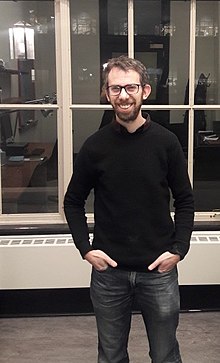| David Isaac Spivak | |
|---|---|
 Spivak in December 2019 Spivak in December 2019 | |
| Born | Los Angeles, California |
| Nationality | American |
| Alma mater | |
| Known for | Ologs |
| Scientific career | |
| Fields | Mathematics Category theory Applied category theory |
| Institutions | Topos Institute |
David Isaac Spivak is an American mathematician and senior scientist at the Topos Institute. He has worked on applications of category theory, in particular ologs and operadic compositionality of dynamical systems. He authored and coauthored the introductory texts on category theory and its applications, Category Theory for the Sciences and An Invitation to Applied Category Theory.
Early life and education
Spivak received his PhD in mathematics from UC Berkeley in 2007 under the supervision of Peter Teichner and Jacob Lurie. His thesis was on derived manifolds, Spivak worked as a postdoc at the University of Oregon and Massachusetts Institute of Technology.
Work
Spivak and Robert Kent developed a human-readable categorical system of knowledge representation called ologs. These were applied, in a series of collaborations with the materials scientist Markus Buehler, to different problems in that materials science. Ologs have been also used by researchers at NIST. The goal of ologs, and of Spivak's book, was to show that category theory can be made relatively easy and thus be understood by a wider audience. Piet Hut endorsed the book saying, "This is the first, and so far the only, book to make category theory accessible to non-mathematicians."
Spivak has also studied dynamical systems and operads.
Spivak and Brendan Fong wrote a book that summarizes the developments in applied category theory for a wide audience, and started a nonprofit applied category theory research institute called Topos Institute, located in Berkeley, California.
Spivak is an editor of a diamond open access journal, Compositionality.
Bibliography
- Spivak. Category Theory for the Sciences, MIT Press, 2014
- Schultz & Spivak. Temporal Type Theory: a Topos-Theoretic Approach to Systems and Behavior, Springer-Verlag, 2019, doi:10.1007/978-3-030-00704-1
- Fong & Spivak. An Invitation to Applied Category Theory: Seven Sketches in Compositionality, Cambridge University Press, 2019, doi:10.1017/9781108668804
References
- "Team". Topos Institute. Retrieved March 30, 2023.
- David Spivak at the Mathematics Genealogy Project
- Spivak, David I. (2008). "Derived Smooth Manifolds". Duke Mathematical Journal. 153: 55–128. arXiv:0810.5174. Bibcode:2008PhDT.......449S. CiteSeerX 10.1.1.244.3704. doi:10.1215/00127094-2010-021. S2CID 18483726.
- "David I. Spivak" (PDF). David Spivak. Retrieved July 10, 2023.
- Spivak, David I.; Kent, Robert E. (31 January 2012). "Ologs: A Categorical Framework for Knowledge Representation". PLOS ONE. 7 (1): e24274. arXiv:1102.1889. Bibcode:2012PLoSO...724274S. doi:10.1371/journal.pone.0024274. PMC 3269434. PMID 22303434.
- Brehm, Denise (8 December 2011). "Researchers link patterns seen in spider silk, melodies". news.mit.edu.
- Chandler, David L. (28 November 2012). "The music of the silks". news.mit.edu.
- Damrad, Kelsey (11 September 2015). "A new molecular design approach". news.mit.edu.
- Padi, Sarala; Breiner, Spencer; Subrahmanian, Eswaran; Sriram, Ram D. (June 2018). "Modeling and Analysis of Indian Carnatic Music Using Category Theory". IEEE Transactions on Systems, Man, and Cybernetics: Systems. 48 (6): 967–981. doi:10.1109/TSMC.2016.2631130. S2CID 21722758.
- Spivak, David I. (2014). Category Theory for the Sciences. MIT Press. ISBN 978-0-262-02813-4.
- Spivak, David I.; Tan, Joshua (4 September 2016). "Nesting of dynamical systems and mode-dependent networks". Journal of Complex Networks: cnw022. doi:10.1093/comnet/cnw022.
- Giesa, Tristan; Jagadeesan, Ravi; Spivak, David I.; Buehler, Markus J. (September 2015). "Matriarch: A Python Library for Materials Architecture". ACS Biomaterials Science & Engineering. 1 (10): 1009–1015. doi:10.1021/acsbiomaterials.5b00251. PMC 4996638. PMID 27570830.
- Spivak, David I.; Ernadote, Dominique; Hammammi, Omar (2016). "Pixel matrices: An elementary technique for solving nonlinear systems". 2016 IEEE International Symposium on Systems Engineering (ISSE). pp. 1–5. arXiv:1605.00190. doi:10.1109/SysEng.2016.7753120. ISBN 978-1-5090-0793-6. S2CID 1156200.
- Fong, Brendan; Spivak, David I. (2019). An Invitation to Applied Category Theory: Seven Sketches in Compositionality. Cambridge University Press. doi:10.1017/9781108668804. ISBN 978-1-108-66880-4. S2CID 199139551.
- Editorial Board, Compositionality. Accessed August 16, 2019.